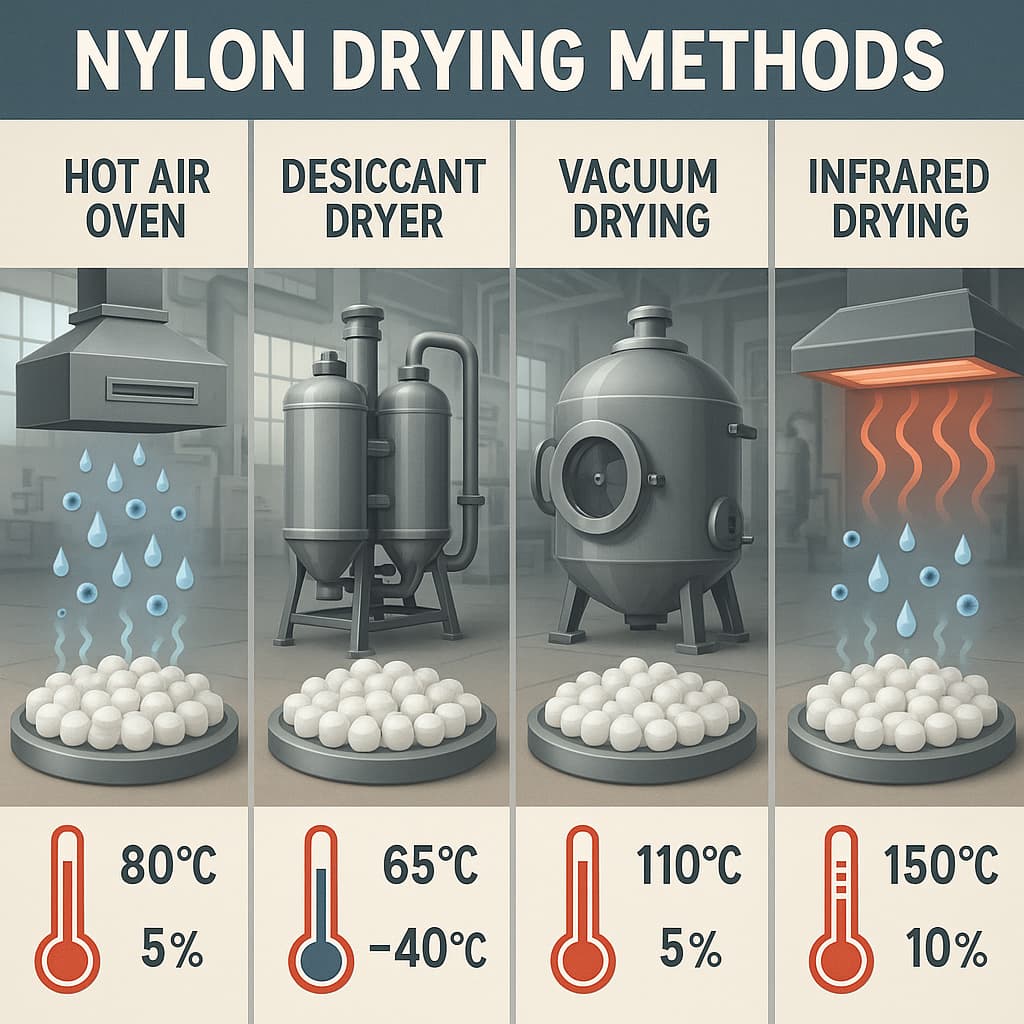Нейлон Будучи высокоэффективным конструкционным пластиком, он широко используется в автомобильной, электронной, электротехнической и машиностроительной промышленности благодаря своим превосходным комплексным свойствам. Однако наличие многочисленных амидных групп в молекулярной цепи придает нейлону сильную полярность, что делает его склонным к поглощению влаги посредством образования водородных связей. Эта присущая ему гигроскопичность влияет не только на размерную стабильность, но и на механические свойства, в том числе и на электрические характеристики, создавая потенциальный риск для прецизионного и долгосрочного применения. Поэтому строгая сушка перед обработкой имеет решающее значение для обеспечения качества продукции.
Влага воздействует на нейлон двумя способами. Во-первых, вода действует как пластификатор, понижая температуру стеклования, размягчая материал, ускоряя ползучесть и снижая размерную точность. Во-вторых, в условиях высокотемпературного расплава остаточная влага вызывает гидролиз, разрывая полимерные цепи, снижая молекулярную массу и значительно ухудшая механические характеристики. При литье под давлением избыточная влажность приводит к образованию сколов, пузырей и плохому блеску поверхности; при экструзии и формовании волокна влажность снижает прочность на разрыв и долговременную надежность. Отраслевые стандарты обычно требуют содержания влаги ниже 0,12% перед обработкой, а для прецизионных деталей – ниже 0,08%.
Распространенные технологии сушки включают: печи с горячим воздухом, сушилки с осушителем, вакуумные сушилки и инфракрасная сушка — каждая из них имеет свои преимущества и ограничения. Традиционные печи с горячим воздухом нагревают окружающий воздух для снижения влажности и испарения влаги, обеспечивая низкую стоимость, но низкую скорость сушки и нестабильные результаты во влажной среде, часто вызывая реабсорбцию. Адсорбционные сушилки используют адсорбенты или роторные системы для снижения точки росы воздуха ниже -30 °C, обеспечивая эффективную и стабильную сушку, что делает их наиболее распространенным промышленным выбором. Вакуумная сушка снижает давление для снижения точки кипения воды, обеспечивая быстрое удаление влаги с тщательным результатом, но более высокую стоимость оборудования и ограниченную пригодность для небольших партий. Инфракрасная сушка использует высокоэнергетическое излучение для проникновения и нагревания гранул смолы изнутри, обеспечивая самую высокую скорость сушки и низкое потребление энергии, хотя и требует тщательного контроля процесса для предотвращения локального перегрева или термической деградации.
Выбор процесса сушки зависит от масштабы производства, стоимость, потребление энергии и требования к продукту. Для крупномасштабного литья под давлением предпочтительны адсорбционные сушилки благодаря их стабильности и автоматизации, в то время как вакуумная или инфракрасная сушка подходит для исследований и разработок, небольших партий или срочных операций. Независимо от метода, строгий контроль влажности с помощью инфракрасных анализаторов или титрования по Карлу Фишеру обязателен. Кроме того, высушенный нейлон необходимо хранить и транспортировать в герметичных контейнерах и закрытых системах для предотвращения реабсорбции.
Контроль влажности нейлона не только обеспечивает точность размеров и механическую прочность, но и критически важен для долгосрочной стабильности и электрических характеристик. С развитием интеллектуального производства будущие системы сушки будут включать мониторинг в реальном времени и управление с обратной связью, обеспечивая более высокую точность и энергоэффективность для удовлетворения потребностей. строгие требования к производительности современных инженерных пластиков.
